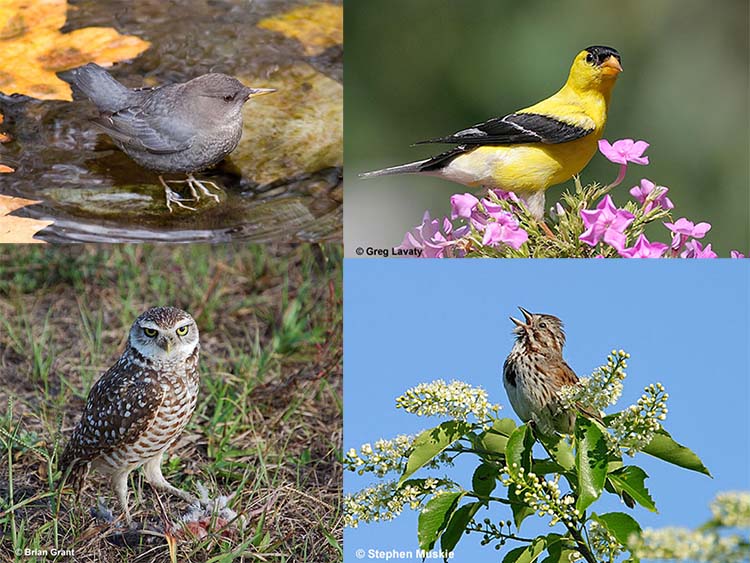
Birds are some of the most fascinating and diverse creatures on the planet, with around 10,000 species that vary greatly in size, shape, color, behavior, and habitat.
From the iconic bald eagle and the majestic peacock to the tiny hummingbird and the elusive owl, birds capture our imagination and inspire us with their beauty, resilience, and intelligence.
Whether you’re a birdwatcher, a nature lover, or simply curious about the world around you, there are certain kinds of birds that everyone should know.
On this page
American Dipper
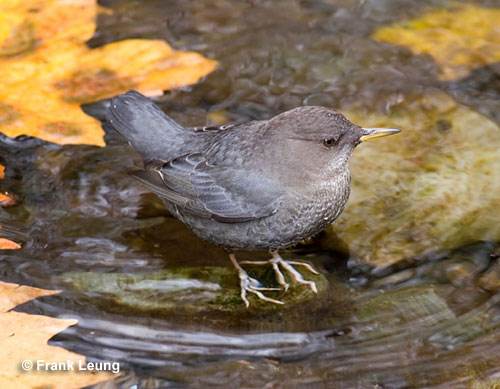
American Dipper
This songbird walks and even swims underwater in icy mountain streams!
The American Dipper has several remarkable adaptations that allow it to forage for insects and larvae while completely submerged in cold, rushing water. Special white eyelids protect its eyes, and its blood is capable of carrying extra oxygen. Wing flapping propels it to the bottom of a stream, where it then walks along, gripping rocks with its toes to push itself forward.
American Dippers often nest behind waterfalls. This wet, steep, slippery, rocky environment provides good protection for its nests, eggs, and young.
American Goldfinch
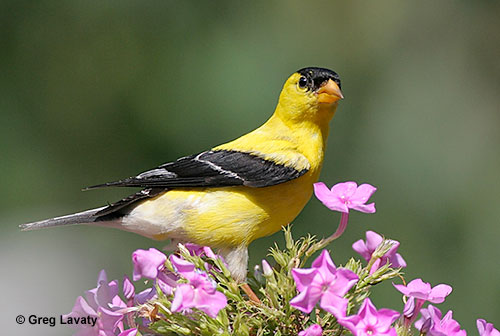
American Goldfinch
While this species does accept cowbird eggs, its biology still provides a double dose of protection that helps it cope with nest parasitism!
The American Goldfinch has a very late nesting season. One suspected reason for this involves one of its primary food sources, thistle seeds, which do not mature until July and August. This is later in the season than most female cowbirds lay eggs, so few goldfinch nests are parasitized.
Because goldfinches feed their young a regurgitated paste of seeds, rather than the insects that most young birds including cowbirds require, young cowbirds in goldfinch nests suffer a protein deficiency and seldom if ever survive.
American Robin
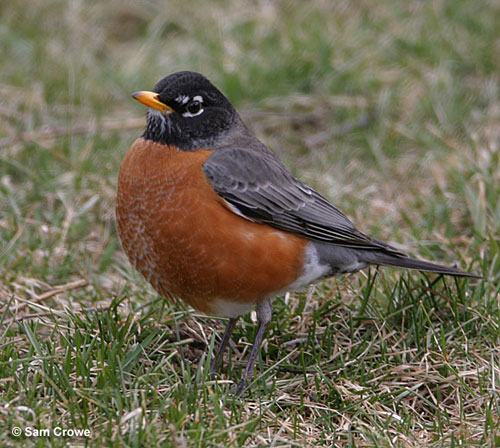
This familiar bird is well known for good reason. It is probably the most numerous bird in North America, with a population of over 300,000,000!
The American Robin occurs over most of the continent during all or part of the year, and is estimated to have a population of 310,000,000. Its adaptability to habitats highly modified by humans, such as towns and lawns, has helped make it so successful.
The Dark-eyed Junco is the only other species with an estimated population of more than 200,000,000 in North America.
Bobolink
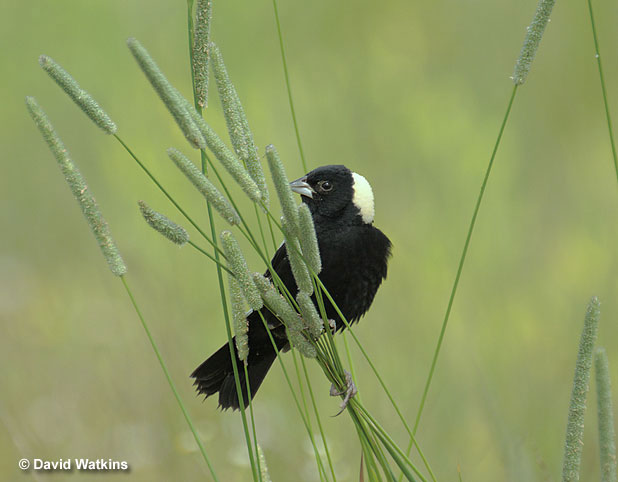
Which songbird turns the usual pattern of bird coloration upside-down by being lighter on top and darker below?
The male Bobolink in breeding plumage is black below, with a yellow head and extensive white on the wings and upperparts. Other songbirds are either uniform in coloration above and below, or are lighter below than above. This unusual pattern in male Bobolinks lasts only from very early spring until August, at which time they molt into plumage resembling the female. The black bill of the breeding male also changes to the paler color of the female’s bill at this time.
Brown Creeper
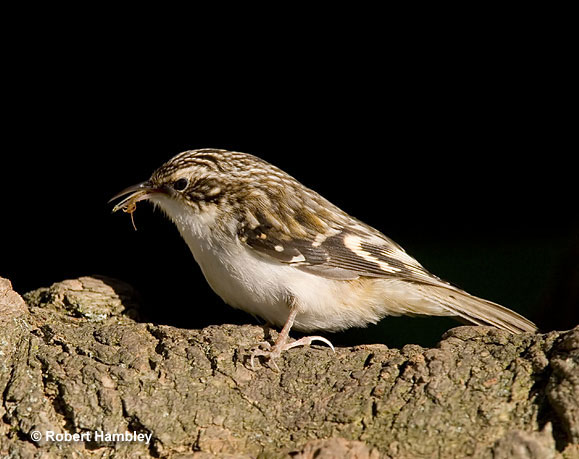
This small, well-camouflaged bird can sometimes be seen climbing up tree trunks in a spiral pattern from the bottom to the top!
The Brown Creeper is slender and only about 5 inches long, and its streaked brown plumage blends in well with tree bark. Its stiff tail feathers are an adaptation shared with woodpeckers that allow it to prop itself against a vertical tree trunk. Its slender, decurved bill helps it probe for small insects and spiders hiding in bark crevices, and its methodical searching often starts at the bottom of a trunk, spirals upwards to near the top, and is followed by a short flight to the bottom of another trunk.
Brown Thrasher
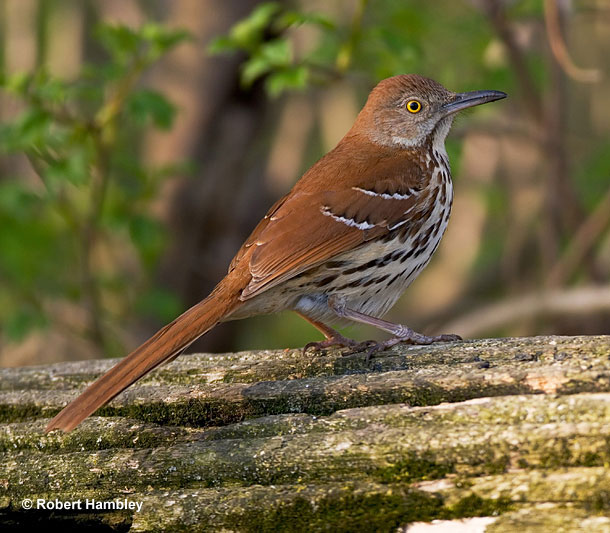
The Brown Thrasher has the largest repertoire of any North American species. Some birds may know as many as 2000 different songs. They may mimic the songs of other birds or other sounds they hear.
The song of the Brown Thrasher closely resembles that of the Northern Mockingbird. However, the thrasher tends to repeat each phrase only twice, while mockingbirds repeat each phrase several times, before moving to the next.
Burrowing Owl
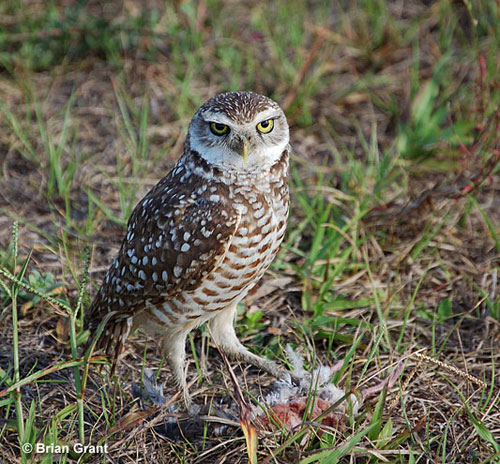
Burrowing Owl
This small, long-legged owl nests underground!
Unlike other owls, the Burrowing Owl nests in underground burrows which, depending on the part of the country, the owls either excavate themselves, or they use abandoned prairie dog burrows. Often found in loose colonies, Burrowing Owls will defend their nest burrows from other Burrowing Owls, but not their foraging areas.
A common myth suggests that Burrowing Owls share their burrows with rattlesnakes. Not true! But badgers can be significant predators of Burrowing Owl nests where the two species occur together.
Cedar Waxwing
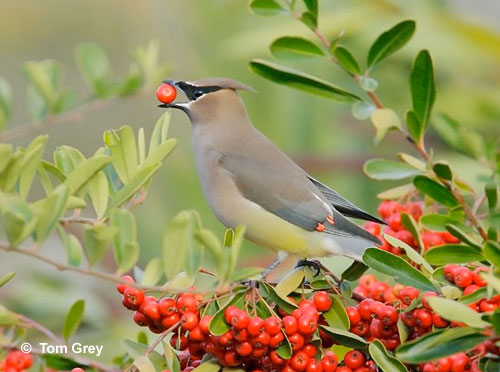
Cedar Waxwing
This bird is well known for occasionally becoming intoxicated, sometimes fatally!
The Cedar Waxwing’s main food consists of fruits and berries. During times of the year when fruits are alternately freezing and thawing, fermentation can occur, producing alcohol. Birds consuming these fruits can become incapable of flight, and can even perish from alcohol poisoning.
Other species of birds that eat berries are also vulnerable to this problem, but the large flocks that waxwings often occur in make them especially conspicuous.
Colima Warbler
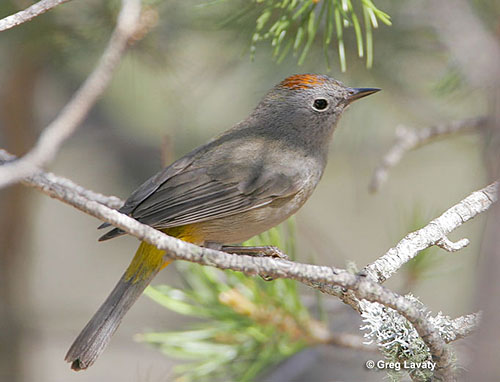
Colima Warbler
This species has one of the smallest and hardest to reach breeding ranges of any warbler that nests in the U.S.!
The Colima Warbler is primarily a Mexican species, and its breeding range in the U.S. is limited to the Chisos Mountains in Big Bend National Park, Texas. A 10-mile round trip hike into the mountains in the late spring or summer is required to reliably see this species in the U.S.
Colima Warblers sing and forage in trees, especially oaks, but they nest on the ground, usually under some kind of protective cover such as rocks or vegetation.
Dickcissel
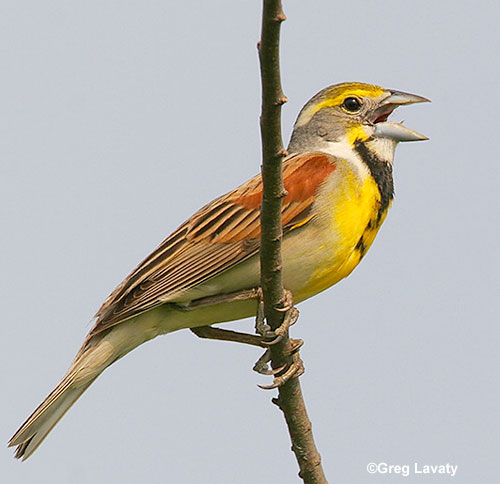
Dickcissel
This species nests in North America, but during the winter it can occur in flocks of a million or more birds in Venezuela!
The Dickcissel, like most songbirds, defends territories during its breeding season, and it is spread out over eastern and central North American grasslands. But it spends its winters in a relatively small area of Venezuela, where it can be an agricultural pest because of its enormous foraging and roosting flocks.
The sight of extremely large flocks of birds whirling through the sky, changing shape as a group and avoiding individual collisions with one another, invokes a sense of awe and wonder. What must it be like to have such a mastery of flight?
European Starling
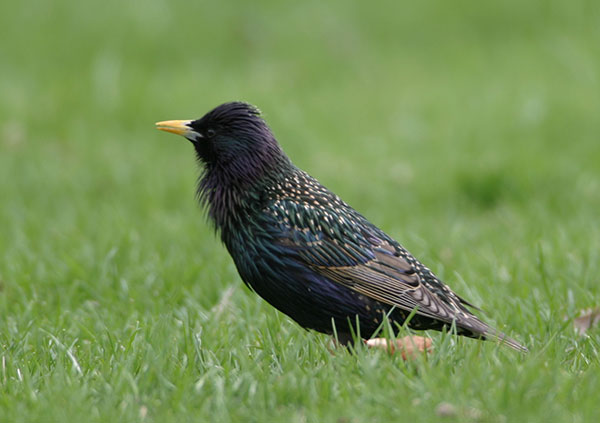
This colorful bird is the European Starling.
A wealthy drug manufacturer and Shakespeare lover, Eugene Scheifflen, decided he would attempt to bring every bird mentioned by Shakespeare to the United States, starting with starlings. The first flocks were located in Central Park. By 1910 the birds were well-established on the East Coast south to Virginia. By 1942 they had spread the width of the United States to California.
Shown here in breeding plumage, the European Starling is a prime example of the risks involved in introducing non-native species into a new country.
Without its traditional population controls, the Europen Starling quickly spread across most of the United States. This aggressive species out-competes many of our native cavity nesting birds and does millions of dollars of agricultural damage in the United States each year.
Harris’s Hawk
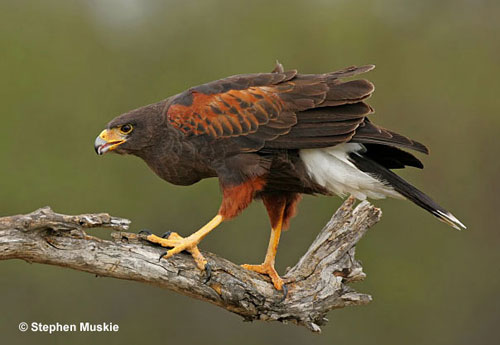
Harris’s Hawk
This hawk has complex social relationships and often hunts cooperatively in small groups!
The Harris’s Hawk of the southwestern U.S. and Mexico often gathers in a ritualized manner on a single perch before heading out for a hunt. Several techniques are employed, including taking turns in long pursuits of running rabbits, flushing prey from cover while other hawks wait to complete the capture, and hawks approaching prey from both above and below at the same time. The hawks then all share in the kill.
Studies have shown that the success rates for capturing prey increase for every additional bird in the group, up to an optimal number of five birds.
Harris’s Sparrow
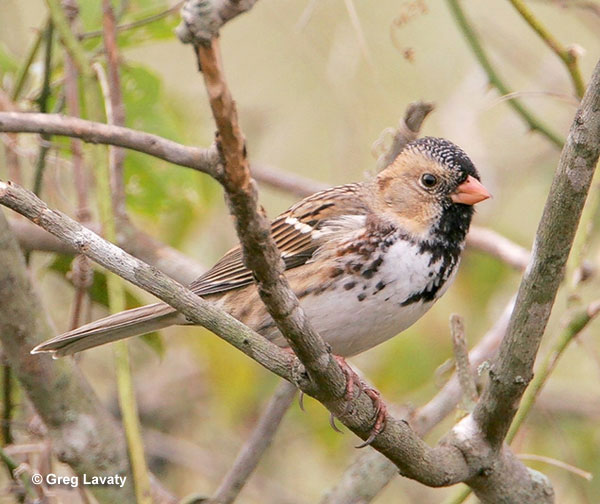
This sparrow typically flies to the top of a bush when startled, instead of diving for cover!
The Harris’s Sparrow spends the winter months in a relatively small area of the south-central U.S., and often occurs in small flocks. Unlike most birds, which usually try to hide in dense cover when disturbed, Harris’s Sparrows perch on the top of a bush or brush pile to have a look around.
The remote northern breeding range of the Harris’s Sparrow helped to make it one of the last songbird nests in North America to be discovered by scientists.
Loggerhead Shrike
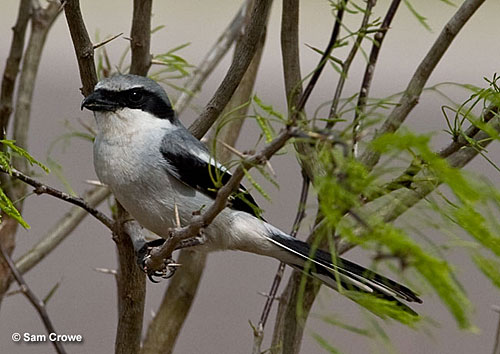
Loggerhead Shrike
Can you identify the young of these small but skilled predators by knowing when they molt?
Northern and Loggerhead Shrikes look quite similar, both as juveniles and adults. Apart from structural characteristics such as the longer, more strongly hooked beak of the Northern Shrike, and plumage characteristics such as the face mask of Northern Shrikes not extending above the eye, an understanding of the molt timing of juvenile shrikes can make the winter identification of a distant individual easier. Juvenile Loggerhead Shrikes molt into adult plumage in the fall, while juvenile Northern Shrikes retain their juvenile plumage until spring, so a brownish shrike with a heavily barred breast seen in the winter months will be a Northern Shrike.
Mississippi Kite
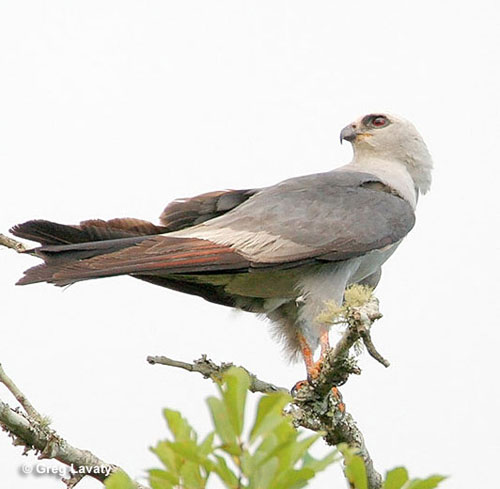
Mississippi Kite
This raptor with red eyes often catches and eats cicadas, beetles, and dragonflies in midair, but can also catch frogs, turtles, and bats!
The Mississippi Kite can sometimes be seen catching insect prey in midair using one or both feet. Then, while soaring, a foot is extended to the bill and inedible parts such as wings are pulled off and discarded, and the prey is eaten.
Mississippi Kites sometimes hunt in groups even during the breeding season, but migration is the time when the largest groups of kites can be observed.
Pine Warbler
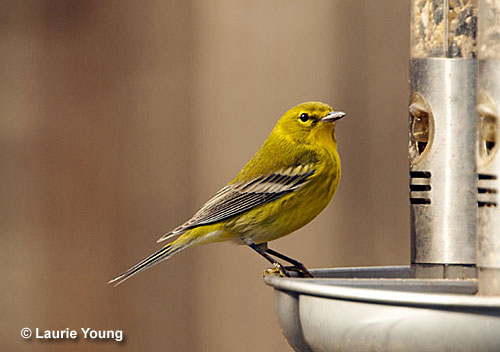
Pine Warbler
This warbler, perhaps more than any other, is known to come to bird feeders!
The Pine Warbler incorporates seeds as a larger component of its diet than most other warblers, which are primarily insect eaters. During winter months especially, Pine Warblers sometimes make regular visits to seed feeders.
During winter, flocks of several dozen Pine Warblers are not uncommon, something that is somewhat unusual among warblers.
Song Sparrow
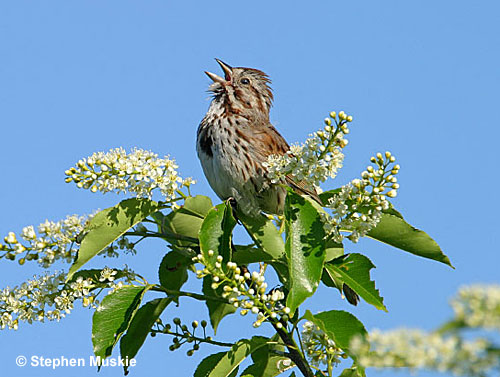
Song Sparrow
Talk about a family tree! This bird has two dozen or more subspecies!
The Song Sparrow has 52 named subspecies, although there appear to be 24 that are truly identifiable. These subspecies vary widely in size, plumage color, and pattern, so if you travel to another part of the country, the Song Sparrows you see may look a bit different than the ones you are used to.
Other birds with many subspecies include the Fox Sparrow, Horned Lark, and Yellow Warbler.
Summer Tanager
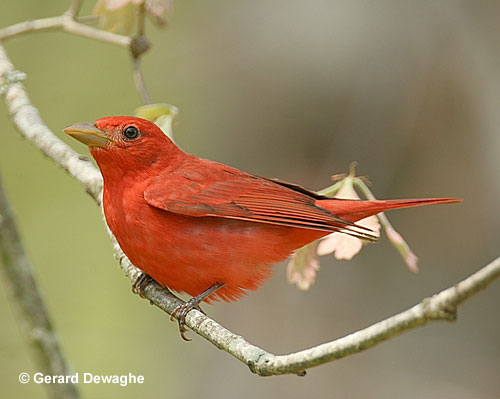
Summer Tanager
This bright red bird is known to eat plenty of bees and wasps!
If you live in the southwestern, southern, or eastern U.S. and you see a bright red bird catching bees or wasps in midair, it is likely a male Summer Tanager. After grabbing one of these insects that most things try to avoid, the tanager will smash it against a branch and scrape the stinger off before eating the rest.
Also be alert for the female Summer Tanager, which is greenish-yellow. Tanagers migrate to Central and South America for the winter.
Wild Turkey
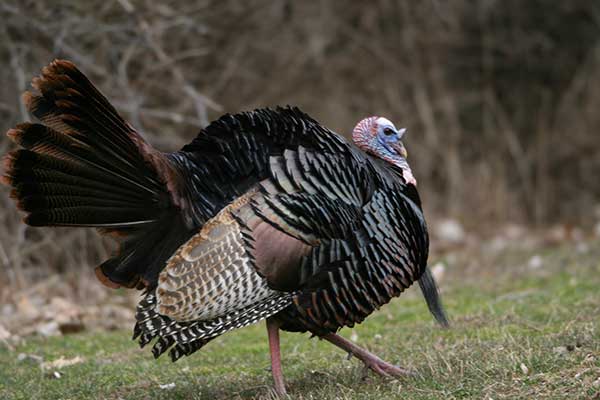
This large game bird was once reduced in number to about 130,000, but conservation efforts have increased its number to about 4 million!
The Wild Turkey population was much reduced in the 1940s due to overhunting and a reduction of suitable habitat. A success story for modern hunting regulations and wildlife conservation, it is now common over both its historic range and in new areas as well.
Wild Turkeys have long been a source of food for people. Only deer bones are more numerous than turkey bones in the remains of Native American villages in the eastern U.S. prior to European colonization.
Wilson’s Phalarope
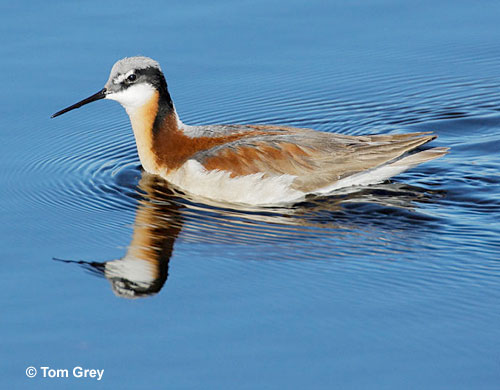
Wilson’s Phalarope
This female bird is far more colorful than the male, and she leaves the male to incubate the eggs!
The Wilson’s Phalarope is the most common inland phalarope, and its biology includes a role reversal that involves the female being both larger and more colorful than the male. The female also turns over all egg incubation and brood rearing duties to the male, while she may look for another mate.
Apart from the nesting season, which is spent in shallow wetlands, Wilson’s Phalaropes spend most of the year in extremely saline lakes in the western U.S.
The male Wilson’s Phalarope is less colorful than the female.
Wrentit

Wrentit
This secretive bird rarely travels more than a quarter of a mile in its life!
The Wrentit occupies coastal scrub and chaparral habitats from Baja, California north through western California and Oregon, and is considered to be the most sedentary bird in North America. After fledging, young Wrentits typically move a quarter-mile or less to establish their own territory, and are strictly non-migratory.
This species is usually well hidden in dense cover, and the song of the Wrentit is often the only clue to its presence. There is a joke among biologists studying this species that because Wrentits seldom fly very far, and when they do fly it is only very low to the next bush, that no one has ever seen the underside of a Wrentit’s wings!

